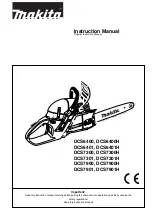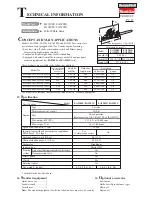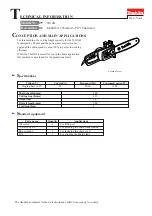
03705/15/99
Petrol
Chainsaws
A heavy-duty 2-stroke machine;
ideal for logging and felling trees
up to 760mm thick.
Operating & Safety Guide 728
728/02
©HSS Hire Service Group Plc 2002 No. 728/02
Group Office: 25 Willow Lane, Mitcham, Surrey CR4 4TS
Web Site: http://www.hss.co.uk
...any comments?
If you have any suggestions to enable us to improve
the information within this guide please fax your
comments or write to the Product Manager at the
address below
Fax: 020 8687 5001
EQUIPMENT CARE
To start a JONSERED
chainsaw...
Turn the ON / OFF switch
to ON,
then
pull the choke
control fully out
to
automatically set the throttle to
the start position.
If the engine is warm, it may
start without any choke. I so,
just pull the choke control out to
set the throttle, then push it
back in.
Give the starter cord a few
firm, fast pulls and the
engine should now start.
Once started, squeeze the
throttle trigger and release
to leave the engine idling, then pull back the chain
brake handle as far as it will go.
Never work with the saw above shoulder height.
Adopt a stable, comfortable stance -
one that gives a good
view of the cut
- keeping the whole of your body clear of
the chain.
Squeeze the throttle trigger to
bring the engine up to
maximum speed and cut vertically
downward or horizontally in a
straight line
without forcing the saw
through the wood.
To help stop the saw ‘kicking back’
out of control,
always
cut with the
underside of the guide bar nearest
the saw body, keeping the front of
the saw body against the wood.
If felling a tree, do not cut lower
that 10” above soil level
and
never
use the saw to cut roots
(this
includes stumps previously pulled from
the ground). Remember, soil is the chains worse enemy and
will blunt a chain in seconds.
NEVER cut with the tip or top edge of the guide bar.
Never let the chain touch the ground, nor any metal or
masonry obstructions. This may also cause kick-back
and will damage the blade.
If the saw does ‘kick-back’, the chain saw’s brake
automatically stops the chain, so, switch OFF the
engine immediately. Check the work to see what the
cause of ‘kick back’ was, then take all necessary steps to
ensure it doesn’t happen again. Reset the chain brake
before restarting
(the chain will not move and the engines
clutch will be damaged if the chain break is not set).
If the guide bar gets trapped in a cut, switch OFF the
saw before freeing it. Don’t lever the bar free or you will
damage the saw.
Make sure you are clear of the saw as it clears the cut.
After finishing a cut, switch OFF before moving on to
another branch or tree.
BASIC TECHNIQUES
Ki
ck
B
a
c
k
Z
o
n
e
Don’t cut through branches that are under tension
unless you have been specially trained. Take your time
and don’t over do it.
You are more likely to have an accident
if you are tired or rushing.
Keep your right hand on the throttle grip and your left
hand on the bar grip at all times.
Support small logs on a saw-horse
or cradle before cutting.
When making a final felling cut to a tree, follow the
next few instructions carefully referring to the
illustration for additional guidance.
The top directional cut is made first, bringing the saw
downwards at 60 degrees to a depth
1
/
4
the diameter of
the trunk. Start high enough up the trunk to ensure you
have enough room for the bottom directional cut.
The bottom directional cut is made by bringing the saw
up at an angle of 30 degrees to meet the top cut. A
perfect directional cut has an angle opening of 90
degrees.
Next, the felling cut is made horizontally on the
opposite side at a level slightly higher than the tip of
the directional cut. The cut is made leaving at least
25mm to act as the hinge. When halfway through the
felling cut, insert a pry bar, or drive a wedge, into the
cut to prevent the saw being trapped.
When the cut is complete remove the chainsaw - turn it
off and put it down in a safe place.
CUTTING GUIDE
Quick Tip
Make a small cut on the underside of any branch
you want to lop, then cut down from the top to
remove it. Never try to cut right through a branch
from one direction or the saw will jam in the cut.
Never push the equipment beyond its design limits.
If it
will not do what you want with reasonable ease and speed
assume you have the wrong tool for the job. contact your local
HSS Hire Shop.
When not in use, store the equipment with the chain bar
cover fitted, somewhere clean, dry and safe
from thieves.
Regularly check the fuel level and top up as
necessary
using 2-stroke oil and unleaded petrol mixed as directed on the
2-stroke oil sachet.
Use only non-fling chain oil to lubricate the guide bar.
Check the chain tension after the first 10 minutes use
and regularly thereafter.
Always switch OFF and wait for the
chain to stop before doing this -
always wear gloves. To
adjust the tension, slacken off the guide bar mounting
nuts, angle the bar upwards, then turn the tension screw
(inside edge of the bar)
- clockwise to tighten the chain;
anti-clockwise to loosen it. Before restarting, re-tighten
the guide bar mounting nuts,
double-check the chain
tension, then, wearing gloves, move the chain back and forth
along the guide bar by hand to make sure it revolves freely.
At the correct tension,
the chain should be slack enough to
be moved by hand with four guide teeth visible above
the bar when pulled, yet tight enough to stay in contact
with the guide bar.
FINISHING OFF
Withdraw the guide bar from the cut and release the
throttle trigger.
Turn OFF the ON/OFF switch and wait for the chain to
stop before putting the tool down. Refit
the chain bar cover.
Let the engine cool then thoroughly clean the saw
ready for return to your local HSS Hire Shop.
Direction
of Fall
NOT LESS
THAN
25mm
60
°
1st Cut
2nd Cut
3rd Cut
(Felling Cut)
30
°
Hinge
1/4
Cutting Guide
Starting Posture




















